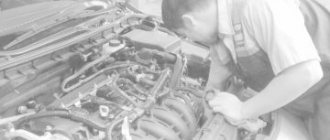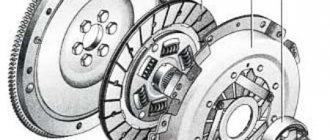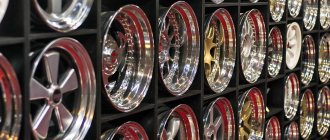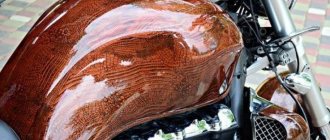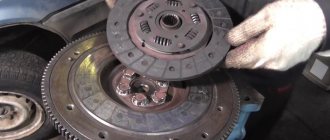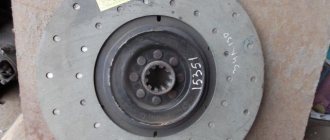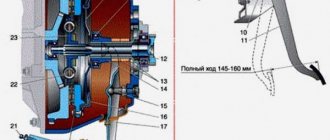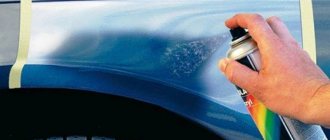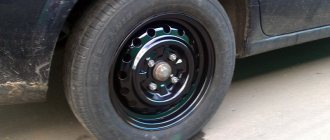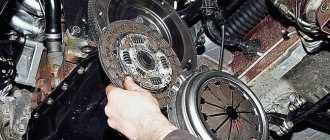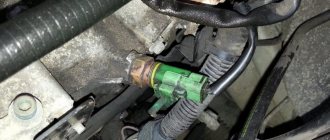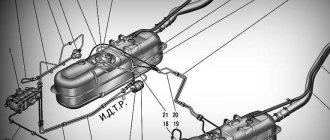The correct choice of wheel rims depends on the technical characteristics indicating all the parameters, namely width, diameter, offset, as well as DIA (hub mounting diameter) and PCD (drilling parameters).
You also need to know the marking designation. It indicates the standard parameters of any type of wheel products:
- stamping;
- alloy wheels;
- forged.
Markings are indicated on the inside. Typically, manufacturers duplicate them in accompanying documents and on packaging if the product is new.
How to measure the drill hole (PCD) of a wheel rim?
Very often we are asked the question of how to correctly measure one of the main parameters of a wheel rim - its drilling (aka PCD). And today we will answer this question in detail.
PCD (Pitch Circle Diameter) - the diameter of the location of the centers of the holes for fasteners on the wheel rim. A couple of examples: 5x114.3 - 5 holes located on a diameter of 114.3 mm; 3x112 - 3 holes, which are located on a diameter of 112 mm; 4x108 - 4 holes with a diameter of 108 mm; 6x139.7 - 6 holes on a diameter of 139.7 mm.
Measuring the drilling of a 4 or 6 bolt wheel rim is not difficult, you just need to measure the distance between the centers of opposite holes.
However, measuring the drilling of a 5-bolt disk is a more non-trivial task, because there are no opposite holes (we consider the opposite hole to be the hole whose chord to the center passes through the center (!) of the wheel disk).
So, to measure the drilling (PCD) of a 5-bolt disk, you need to take two measurements and then add the two obtained values.
Due to its specific nature, we will, of course, carry out measurements on a wheel spacer, and not on a wheel rim, but this does not change the essence at all.
Measurement No. 1: distance from the inner edge of one of the 5 holes to the central hole (DIA) of the wheel rim:
Measurement No. 2: distance from the outer edge of one of the 5 holes to the opposite side of the central hole (DIA) of the wheel rim:
The result of the second measurement is 92.0mm :
We add the two obtained values: 20.0 + 92.0 = 112mm Thus, drilling the wheel rim (spacer-adapter in our case) has a value of 5x112 (where “5” is the number of holes, “112” is the diameter of their centers in millimeters).
Let's consolidate the knowledge gained with one more example. This time we will take measurements not with a caliper, but with a regular ruler .
We measure the distance from the inner edge of one of the holes (any) to the CO (central hole, DIA):
Next, we measure the distance from the outer edge of one of the holes (again, any) to the opposite side of the CO. Make sure that the ruler passes strictly through the center of the wheel rim!
Add: 20.0 + 92.0 = 112mm, i.e. in this case, the value of the measured drilling is still the same 5x112 !
One of the main parameters of wheel rims is the number of mounting holes and their location relative to the wheel axis. The English term PCD, in domestic auto slang called a bolt pattern, contains information about the number of studs or bolts, as well as the diameter of the circle in which their centers are inscribed.
For example, a typical size for VAZ cars will be designated as PCD 4 x 98 .
This is interesting: Why do you need wheel balancing?
What does the width of a car rim affect?
Each cast or forged wheel requires a personal version of tires that will fit the basic parameters of the manufacturer. If you make the wrong choice, you can face a number of problems. It is difficult to make a mistake with the diameter, because setting the wrong size is problematic. But it’s quite easy to make a mistake in width measurements. Designs that are too narrow or wide will adversely affect the design profile of the tire. This will lead to deterioration in performance, such as reduced sidewall stiffness.
What effect does the width of the vehicle structure have?
Many people often wonder what the width of the rim affects. Experts say that the rim size of the product should be 25% smaller than the width of the rubber profile. For the presented standard size 195/65 R15 91 T, the width of the structure can be calculated as follows:
- First, the profile width is calculated.
- Next, 195 should be divided by 25.4, resulting in 7.68 inches.
- You need to subtract 25% from this value, and then round the result.
- The formula is as follows: 195/25.4-25%=5.76.
- Next, you need to round the number to get a disk 6 inches wide.
Without replacing the tires, there is no point in installing components of increased width; the behavior of the car changes only within the limits of measurement error. If the disc is heavy, then it contributes to the deterioration of the smoothness and controllability of the vehicle.
Features of bolt patterns of different types of disks
Today on the market you can find the following types of wheels for cars:
- stamped (steel);
- cast (light alloy);
- forged.
Steel models have gained popularity due to their modest cost, as well as the ability to straighten dents (they rarely crack and usually do not require expensive welding). Straightening is available for them due to their high strength - such a model will not burst even in a direct collision. The stamping bolt pattern must comply with standard standards.
Cast models are quite light, but not so durable during operation. The bolt pattern of wheel rims, the compatibility tables of which are presented by each manufacturer, must also fit into the standard standard.
Forged models are quite rigid and durable. During operation, they do not burst (it is extremely difficult to even make a dent on them), and are also not subject to the destructive effects of corrosion. In addition, if a forged wheel has a dent, it can be repaired by rolling it in a car service center.
Studying the markings
- Each disk is marked with a set of numbers and Latin letters. To those who were not interested in what it all means, they will seem like Chinese letters. Meanwhile, the marking carries complete information about the disk;
- The first number in the row indicates how wide the disk is in front of your eyes. It is measured in inches;
- The next number after the separator indicates the diameter of the disk. Units of measurement are the same inches;
- The two letters and number following it show the so-called offset (or offset, as you call it) of the disk, and this time it is in millimeters;
- After the letters PCD
(which stands for “
Pitch Circle Diameter
,” which implies international standardization of diameter), there is a number - the slope - a three-digit number. This is exactly the chatter we are looking for.
Let's look at the code:
And what do these mysterious numbers mean? Their decoding is quite simple. The first number shows how many bolts it is attached to. After the fraction sign, it indicates the diameter of the circle along which the mounting holes are made. And if these numbers on the new disk do not match those indicated on the old one, then the problems described above await you.
Tire calculator - inches
To convert American tire sizes (in inches) to European tire sizes (in mm), you can use a tire calculator for inch sizes.
For example, you need to recalculate the American tire size marked 31X10.5 R15
- to European.
We enter 31 x 10.5 x 15 and get the calculation result: 267/76 R15
, and just below will be shown the standard size
265/75 R15
.
You can read more about American tire markings in inches in the section: Tire markings in the USA.
Source
Disc bolt pattern
If you like to read car magazines and look at new car models, you've probably noticed that at auto shows they look much better than the production models offered in showrooms. That's right, any auto show is designed for manufacturers to show their new developments in a favorable light and attract public attention to them.
Many drivers love to style their cars. We have already written on our website Vodi.su about various types of styling and tuning: disc lighting, equalizer for the rear window, increasing engine power. I would like to talk about disks. You can give your car a sporty look by lowering the ground clearance and installing non-standard cast or forged wheels with low-profile tires mounted on them.
It would seem that everything is simple - remove the old disks, buy new ones, screw them to the hub and enjoy the new look of your car. However, you need to be able to choose the right wheels, which are marked in a special way. That is, you need to learn to read wheel markings.
Wheel rim markings - main parameters
In fact, when choosing a wheel rim, you need to pay attention to many parameters, and not just the rim width, the number of bolt holes and diameter.
Let's give a simple example. 7.5 Jx16 H2 5/112 ET 35 d 66.6 . What do all these numbers and letters mean?
So, 7.5x16 is the size in inches, the width of the rim and the bore diameter.
An important point is that the “x” icon means that the disk is one-piece, that is, not stamped, but most likely cast or forged.
The Latin letter "J" indicates that the edges of the rim are suitable for single-wheel drive vehicles.
If you were looking for a wheel for an all-wheel drive car, you would need to look for a wheel marked “JJ”.
There are other designations - JK, K, P, D and so on. But it is the “J” or “JJ” types that are the most common today. In any case, the instructions should indicate which types of disk are suitable for your machine.
H2 - this designation indicates that there are two annular protrusions on the rim - Hamps. They are needed to ensure that the tubeless tires do not slip off. There may also be discs with one hump (H1), without them at all, or with protrusions of a special design; accordingly, they will be designated CH, AN, FH. It is worth noting that if you want to install RunFlat tires, then you will need H2 wheels.
We will look at what 5/112 is below, because this parameter precisely shows the disc bolt pattern.
ET 35 - disc offset. This parameter indicates how much the plane of application of the disk to the hub deviates from the axis of symmetry of the rim.
Departure can be:
- positive - the area of application extends beyond the axis of symmetry, and to the outside;
- negative—the application area is concave inward;
- zero - the hub and the axis of symmetry of the disk coincide.
If you want to carry out tuning, then you need to pay special attention to the disc offset - deviation from the standard indicators is allowed, but not more than a few millimeters, otherwise the load on both the discs themselves and the hub will increase, and accordingly on the entire suspension and steering control.
D 66.6 - diameter of the central hole. If you can’t find an exact matching diameter, you can buy discs with a larger central hole diameter. In this case, you will need to select a special set of spacer rings, due to which the dimensions can be adjusted to the required diameter of the landing cylinder on the hub.
Wheel rim bolt pattern
If everything is more or less clear with the dimensions and design features, then the bolt pattern may raise questions for many.
In the example above we see a figure of 5/112. This means that the wheel is screwed to the hub using 5 bolts, and 112 is the diameter of the circle on which these 5 holes for the wheel bolts are located.
It often happens that this parameter differs by fractions of a millimeter for different models. For example, Zhiguli wheels come with a bolt pattern of 4/98. If you buy 4/100 disks, then they will not be visually different, and they will sit in their seat without any problems. But while driving, this discrepancy will quickly remind itself of itself - a beating will appear, which will gradually lead to deformation of the disk, the hubs, wheel bearings will quickly break, the suspension will suffer, and along with it your safety. You will also feel vibrations in the steering wheel. If measures are not taken in time, the wheel may simply come off.
You can calculate the bolt pattern yourself.
To do this you need:
- count the number of bolts;
- measure the distance between two adjacent bolts using a caliper;
- depending on the number of bolts, multiply the resulting distance by 1.155 (3 bolts), 1.414 (4), 1.701 (5).
If this simple mathematical operation results in a fractional number, then it can be rounded up. In addition, any manufacturer has bolt pattern tables, and if you have an indicator of 111 for Mercedes, then in the catalog you can see that Mercedes does not use wheels with such a bolt pattern, so the correct choice would be 112.
Please also note that even with a slight discrepancy, you will not be able to tighten the bolts completely, hence all the troubles associated with disk runout.
When selecting disks, you also need to check whether the holes match the diameter of the hub bolts. If you buy a disk complete with hub bolts or studs, then the threads should also be suitable. All these parameters can be found in numerous reference books.
Let's give an example: we are selecting a wheel for a Mazda 3.
Using the open access directory, we find:
- bolt pattern - 5x114.3;
- hub hole diameter - 67.1;
- departure - ET50;
- size and thread of wheel studs - M12x150.
That is, even if we want to choose wheels with a larger diameter and wider ones to make the car look more sporty and “cool,” the bolt pattern and offset parameters should still remain the same. Otherwise, we risk breaking the suspension of our Mazda Three, and repairs will result in unforeseen expenses. In any case, if you cannot find the information on your own, you can contact an official service station, dealer showroom or spare parts store, whose employees should have all this information.
Tire calculator
This tire size calculation is theoretical. Unless absolutely necessary, you should not install tires on your car that are not recommended by the manufacturer.
Before installing tires, you must:
- make sure that the changes will not lead to problems (mechanics, body, dimensions, etc.);
- ensure that the tires installed comply with existing rules and do not violate them;
- Make sure the rim width and diameter correspond to the tire characteristics.
You also need to remember that changing tire sizes often changes such an important indicator as the load index.
main disk sizes
The most common wheels are found, except for those that came from old FIAT models and some other cars, VAZ PCD 4 x 98 , with 4 and 5 bolts (studs).
The most popular bolt patterns:
- 4×100;
- 4×108;
- 5×100;
- 5×108;
- 5×112.
Although it is difficult to judge the actual prevalence of specific sizes, there are many others used on fairly well-known mass-produced cars.
Naturally, the disc parameters are not limited by the size of the bolt pattern.
There are others, no less important:
- diameter of the central hole;
- width;
- departure;
- disc edge parameters and much more.
This is interesting: When is it prohibited to drive on winter tires?
Permissible deviations
For individual parameters, certain deviations are permissible without a negative impact on vehicle handling and
Disc diameter. On alloy wheels, a 1-inch increase in size is allowed.
Disc width. Tolerance is 0.5 inches.
DIA – The size of the center hole should ideally match the diameter of the hub. Permissible deviation up to +0.3 mm.
ET – it is advisable to adhere to standard sizes. Allowable change in offset up to +/- 2 mm.
Note! The PCD parameter is determined with absolute precision. The number of mounting holes must exactly correspond to the declared values. Errors are not allowed.
Calculation formula and compatibility tables
If there are an odd number of holes, one measurement will not work. In this case, you need to measure the distance between the axes of two adjacent bolts, and then apply simple formulas for calculations.
Let's say the distance is equal to some number X. Then, depending on the number of bolts from 3 to 5, the following formulas are used:
- 3 bolts. PCD=1.155*X
- 4 bolts. PCD=1.414*X
- 5 bolts. PCD=1.701*X
The formulas are obtained as a result of simple geometric manipulations; everyone can personally check and obtain more accurate coefficients.
As approximate reference information, you can use the table of compatibility of car models based on the same PCD.
As mentioned above, this cannot in any way mean complete interchangeability of disks, since all their other parameters rarely coincide.
| Disc size according to PCD | The most common cars where it is used |
| 4×98 | Alfa Romeo 33, 155, 164, FIAT 124, 126, Brava, Cinquecento, Croma, Multipla, Palio, Panda, Punto, Seicento, Tempra, Tipo, Uno, Lancia Delta, Lada |
| 4×100 | Old models Audi, Mini, BMW 3, Daewoo Espero, Lanos, Nexia, Daihatsu Charade, Cuore, Grand Move, Honda CRX, Civic, Accord, Integra, Jazz, Kia Spectra / Sephia, Mazda 121, 323, MX5, Mitsubishi Carisma, Colt, Lancer, Nissan Micra, Sunny, Opel Ascona, Astra, Calibra, Corsa, Kadett, Vectra, Zafira, Renault Clio, Espace, Kangoo, Megane, Twingo, Seat Ibiza, Toledo, Skoda Felicia, Suzuki Baleno, Toyota Corolla, Yaris , Volkswagen Golf, Jetta, Passat, Polo, Volvo 440 |
| 4×108 | Audi 80, 100, Citroen BX, ZX, Berlingo, Visa, Xantia, Xsara, Ford Escort, Fiesta, Ka, Mondeo, Peugeot 106, 205, 206, 306, 307, 405, 406, Partner, Saab 900, 9000, Volvo 850 |
| 4×114,3 | Daewoo Matiz, Honda Civic VTEC, Accord, Prelude, Hyundai Accent, Sonata, Mitsubishi Carisma, Colt, Galant, Lancer, Space Wagon, Nissan Almera, Primera, Suzuki Alto, Swift, Volvo S40, V40 |
| 5×100 | Audi A3, TT, Skoda Octavia, Subaru Forester, Impreza, Legacy, Outback, Toyota Avensis, Carina, Celica, Volkswagen New Beetle |
| 5×108 | Citroen XM, Jumper, Ferrari, Ford Focus, Mondeo, Volvo 740, 760, 780 |
| 5×112 | Audi 100 CS, Quattro, Audi A4, S2, S4, A6, A8, Ford Galaxy, Mercedes Benz 280SL, 600SL, SLK, A, Vito, Volkswagen T1, T4 |
| 5×114,3 | American cars, Daihatsu Terios, Honda Odysee, CRV, Lexus, old Mazda models, Toyota RAV4 |
| 5×115 | American cars |
| 5×120 | Range Rover, Rolls Royce |
| 5×139,7 | Lada 4×4, Chevrolet Niva, UAZ |
It should be borne in mind that the wheels that were equipped with the cars could differ greatly depending on the specific modification of the model and the equipment ordered.
Compatibility tables
No one argues with the fact that bolt pattern can be determined independently using the appropriate tools and special formulas for calculations. But in the current conditions there is absolutely no need for this. To facilitate the selection process, there are special compatibility tables for wheel bolt patterns. The motorist only needs to find the table provided for his make and model of car. It is also very easy to determine the correct bolt pattern using the information provided in the official owner's manual. There is data about all sizes, offsets, diameters and much more. Depending on what diameter of wheels and tires the owner wants to use, the manufacturer makes recommendations for each case.
It is important to understand that all cars have their own restrictions regarding minimum and maximum wheel diameters and tire parameters. It is strongly not recommended to go beyond their limits, as this may result in negative changes in the operation of the suspension, increased wear of parts, and also increased fuel consumption.
There are a number of car owners who ignore manufacturers' recommendations and do not take into account information from compatibility tables. Their goal is to save on the purchase of parts. Therefore, they buy discs that are not quite suitable, begin to widen the hub holes, and make additional slots for mounting bolts. Some go further, changing the location of the wheel-to-hub mounting points. And already in this form the product is installed on the vehicle. In theory, such modernizations have a right to exist. But only on the condition that all calculations and work were carried out as accurately as possible. But it is impossible to achieve this using a makeshift method in a garage. If you drill the holes incorrectly, the wheels will start to beat and the hubs will collapse. And the car’s suspension will very quickly become unusable.
Modifying wheels that do not meet the standards of your car if you want to get a result close to the factory one is extremely unprofitable economically. You will have to spend a significant amount of money on the work. It is much cheaper to purchase wheels that are already fully regulated by the manufacturer, the efficiency and performance of which will not be doubted.
conclusions
A serious approach to purchasing new discs ensures safe travel and eliminates the issue of unnecessary financial costs for suspension repairs. Let's summarize.
When selecting new rims, consider 6 main parameters. As well as the manufacturer's recommendations for your car model.
Study the operating instructions in detail - this is the easiest way to find the required characteristics.
There are no instructions, but the car is equipped with branded wheels - look at the markings on the inside of the disk.
Determine the missing values yourself. Be attentive to those indicators whose measurements do not allow errors.
Choose the right wheels for your car.
Source
Departure parameter
In the example under consideration, the “offset” indicator is 30. This means that the gap between the center of the width of the wheel rim and the so-called mating plane is 30 millimeters. The last parameter is the plane with which the wheel disk is pressed directly to the hub. Note that the product will have zero “overhang” if they are absolutely identical. The “offset” can be considered positive if there are no points of intersection of the two mentioned planes. If the transfer plane goes beyond it will be negative.
German concerns that produce wheels designate the “offset” parameter with the symbols ET. In the example we are considering, this indicator is positive (YE30). A negative offset will be indicated as ET-30 (with a hyphen). French manufacturers designate this parameter as DEPORT. In other countries, as a rule, the designation OFFSET is used.
The “offset” indicator is no less important than the bolt pattern. It must be taken into account when installing wheels. If “offset” has a negative value, this may cause the element to protrude outward. In this case, when turning, it will rest against the wheel arch. Positive “overhang” implies a preferential location of the disk inside. If you do not take into account the correspondence of the “offset”, it will simply be impossible to carry out installation. This is due to the fact that the suspension elements will prevent this.
Is it possible to install a product with inappropriate parameters?
It is possible to install the product on a car with unsuitable bolt pattern parameters. For this purpose, special rings called centering rings are often used. With their help, you can set a parameter specifically for installing selected disks. This may result in errors in balancing and violation of suspension geometry. Therefore, it is strictly not recommended to carry out such operations, since they can disrupt the performance of the machine in motion.
The bolt pattern is an important parameter that can be used to determine how the disc is attached to the chassis structure. You can measure it yourself or find out from official sources, which is preferable.
Related posts:
- What is the wheel bolt pattern on a Chevrolet Lanos?
- How to determine wheel bolt pattern
- I will buy stamped wheels for 14 Samara
- Iron wheels r13 for VAZ
Tire calculator
This tire size calculation is theoretical. Unless absolutely necessary, you should not install tires on your car that are not recommended by the manufacturer.
Before installing tires, you must:
- make sure that the changes will not lead to problems (mechanics, body, dimensions, etc.);
- ensure that the tires installed comply with existing rules and do not violate them;
- Make sure the rim width and diameter correspond to the tire characteristics.
You also need to remember that changing tire sizes often changes such an important indicator as the load index.
